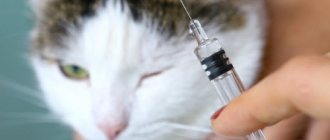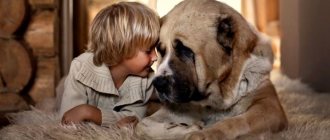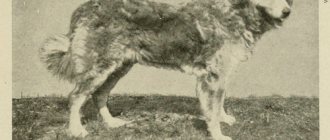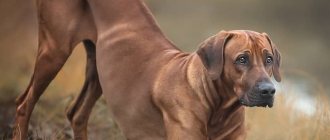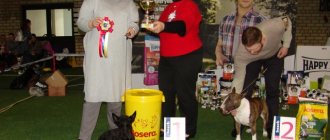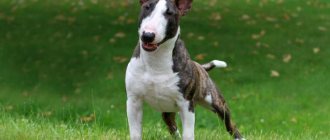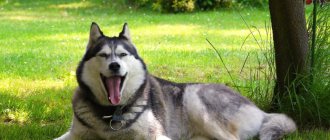The Rhodesian Ridgeback is the only breed native to South Africa that has received FCI recognition (their fellow Boerboels have not yet received this honor). Initially, dogs were used to protect livestock, homes and hunt mainly large animals; another name is the African lion hound. Today, ridges are increasingly used as companions and guards.
History of the origin of the breed
Since time immemorial, the ancestors of modern Ridgebacks lived among the natives of South Africa - the Hottentots. Their distinctive feature was the ridge - a narrow, long section of skin along the back, on which hair grows in the opposite direction. Few breeds can boast of having such decoration, or rather three: African and Thai Ridgebacks, as well as the indigenous Vietnamese Phu Quoc dogs.
In 1505, the Englishman Thiell described the indigenous people of South Africa and could not help but mention their unusual dogs with a crest on their backs. Europeans learned more about the merits of African lion hounds only with the beginning of active colonization in the 17th century. The Dutch, Germans, French and English who arrived in South Africa brought with them livestock and four-legged helpers (bulldogs, terriers, mastiffs, pointers, etc.), which they crossed with local livestock. In addition, uncontrolled crossing of local and visiting dogs constantly occurred.
Ridgebacks are natural hunters and excellent guards; they were traditionally kept on farms to protect homes and livestock.
At the end of the 19th century, an African farmer of European origin, Cornelius Van Roer, became interested in Ridgebacks. For 35 years he was involved in breeding and improving the breed. For some time, African hounds were even called “Van Roer dogs.” The dominant trait - the ridge on the back - was preserved despite prolonged interbreeding.
The first breed description based on the Dalmatian standard was developed by Frederick Barnes in 1922. It was revised and approved by the Kennel Union of South Africa (KUSA) in 1926. In 1963, the FCI adopted the current standard and officially registered the Rhodesian Ridgeback breed under number 146.
Video review of the Rhodesian Ridgeback breed (African Lion Hound)
My name is Spesivykh Anna, I am the owner of the professional kennel of Rhodesian Ridgebacks RKF FCI Ridge's Star . My passion for Rhodesian Ridgeback dogs dates back to 2002. I read a lot about the Rhodesian Ridgeback breed, looked at photos of Ridgebacks, read forums about Rhodesian Ridgebacks. I was fascinated by the Ridgeback breed, and I bought a Rhodesian Ridgeback puppy - a magnificent Rhodesian Ridgeback bitch, Rebecca Ridge's Star . Rebecca Ridge's Star is the daughter of the famous Swedish male, Best Producer of the Russian Championship "Rhodesian Ridgeback-2003", Interchampion and Multi-Champion Lovfallan's Master , who descends from a pair of Multi-Champion Ridgeback dogs, and in her pedigree has such super Ridgebacks as World Champion '96 Rydgeway African Hunter and Besal Fatoka , who are the sires of many champions and winners of the largest Rhodesian Ridgeback shows around the world.
In 2004, I registered the Rhodesian Ridgeback kennel Ridge's Star . In 2005, the first Rhodesian Ridgeback puppies were born in our ridgeback nursery from a field mating in Holland. Ridgeback puppies from this litter currently have the titles: Junior Champion of Russia, Junior Champion of VDH, Champion of Russia, Belarus, Lithuania, Croatia, Macedonia, Bulgaria, Poland, Ukraine, Estonia, European Champion 2007 , at the 2006 World Championships in Poznan they became prize-winners of the Rhodesian Ridgeback breed. In 2013, another Rhodesian Ridgeback from our kennel was very pleased to become the Junior European Champion 2013 ! You can find out more about our Rhodesian Ridgeback puppies in the Ridgeback puppies section of our Ridge's Star kennel.
In January 2005, in order to obtain new Champions of the Rhodesian Ridgeback breed from our Ridgeback kennel, we decided to buy a Ridgeback puppy Heshima ya Kimba Fuku Shabalala (Shabi) from South Africa from the famous German Rhodesian Ridgeback kennel Heshima ya Kimba. The beautiful Ridgeback Shabi was used for breeding by the Ridge's Star , and now we are delighted with his beautiful children and grandchildren - holders of many Rhodesian Ridgeback breed titles. Over the years of my fascination with this wonderful breed of Ridgeback, the Ridge's Star has grown and has produced many excellent Rhodesian Ridgeback puppies: bright, beautiful representatives of the Rhodesian Ridgeback breed. The descendants of the founders of the Champion line of the kennel Rebecca Ridge's Star and Heshima Ya Kimba Fuku Shabalala (imported from South Africa) consistently win exhibitions of the highest rank, and together, as a single team, they often win competitions for kennels and producers of Rhodesian Ridgebacks.
So in June 2015 our kennel Ridge's Star was the Best Kennel of Rhodesian Ridgebacks of the 2015 World Championship!!!!
And at the general competition of kennels of all breeds, the Rhodesian Ridgeback kennel Ridge's Star took 4th prize!!!
I hope you enjoy the website of my Ridgeback kennel Ridge's Star about this wonderful and very beloved breed. On its pages you can learn more about Rhodesian Ridgeback dogs, visit the gallery where you can find many excellent photos of our Rhodesian Ridgebacks, taken by both photography enthusiasts and professional animal photographers. If you want to buy a Rhodesian Ridgeback puppy, go to the “Puppies” , there you will always find information about the Ridgeback puppies offered or planned litters. I sincerely love my Ridgebacks, they are full members of my family. If you are interested in the Rhodesian Ridgeback breed, I will always be happy to answer all your questions, Anna.
Appearance and standards
The Rhodesian Ridgeback is a perfectly balanced, agile, strong and muscular dog, symmetrical in all its outlines, capable of fast, long running. The movements are light and elegant. Height – 60-70 cm, weight – 28-35 kg. In many ways, the breed is similar to the Hungarian Vizsla.
Head and muzzle
The skull is of medium length, level between the ears. The ears, wide at the base, are set high, have rounded tips, and fit tightly to the head. The eyes are moderately spaced and round. The color ranges from light to dark brown and should be consistent with the coat. Cheeks are smooth. Jaws are strong with correct bite. The nose can be either black or brown; the degree of pigmentation must correspond to the color of the eyes. At rest there are no folds on the head.
Torso
The chest is not wide, but quite roomy and deep. The ribs are moderately springy, not rounded. The tail is carried in a slightly curved state, strong, gradually tapering towards the tip. The back is straight. The limbs are strong and bony with well-defined muscles and strong tendons.
Coat and colors
The coat is short and dense, fits well to the body, glossy and shiny. The color can be anything from light reddish to wheaten. A small amount of white markings on the chest and toes is allowed, as well as light shading on the muzzle, ears and tail.
Ridge
The ridge on the back is formed by hair growing in the opposite direction in relation to the main coat. The correct ridge is perfectly symmetrical, starts behind the shoulders and stretches along the back to the hips, gradually narrowing, its average width is about 5 cm. There must be two identical curls located in the upper third.
Description of the breed
The description of the breed has not changed since its approval. The beauty of the Rhodesian Ridgeback, according to many experts, lies in the amazing combination of power and grace. These strong dogs look elegant, have a beautiful body, their appearance, walking, and facial expression exude nobility and poise; their impressive size is not a hindrance to this.
The breed standard provides for the following appearance features:
- the average weight of an adult Rhodesian Ridgeback is 32-36 kg;
- height at withers – 65-69 cm;
- the head is symmetrical, the skull is moderately wide;
- cheekbones stand out well;
- thin lips, strong teeth, correct bite;
- the nose is black or liver color, depending on the color of the eyes;
- eyes slightly oval, any shade from light to dark brown;
- large, hanging ears; when the dog is relaxed, they hang down to the cheeks, lying close to them;
- body rectangular, muscular;
- the chest is wide;
- the back has developed muscles, noticeable in any position of the pet;
- the tail is of medium length, tapering to the tip;
- paws are muscular, the hind legs are slightly larger than the front ones, muscular.
A peculiarity of the external characteristics of the representatives of the breed is the presence of a dorsal ridge. On it the fur is directed in the opposite direction than on the rest of the body. This area should stand out well and be visible to the naked eye. Its length starts from the base of the withers to the croup.
Colors
The coat of the Rhodesian Ridgeback is the same length throughout the body, with the exception of the muzzle, where it is slightly shorter (no more than a few millimeters). The hairs lie tightly to the body, are pleasant to the touch, and shine in the sun. It is believed that beautiful, soft wool is one of the pride of the breed.
The norm allows for a variety of colors of the red palette. The presence of white spots is impossible. Only a small amount of light hair is allowed in the chest area, between the toes. There is often a dark mask on the muzzle.
Character and psychological portrait
The Rhodesian Ridgeback is balanced, determined, active, intelligent and independent. He will become a devoted friend and a fearless guard and assistant. He takes protecting his family and property, including his car, very seriously. Able to analyze the situation and make decisions. At the same time, he has a sensitive psyche, the dog is characterized by touchiness and stubbornness, he feels and understands the owner’s mood. Absolutely does not tolerate loneliness or unfair treatment.
In normal circumstances, Ridgebacks do not show aggression or express timidity: they are self-confident and indifferent to strangers. Always alert and curious with a well-developed hunting instinct. They don’t bark in vain, they only use a menacing voice when necessary.
With other dogs they behave friendly, with interest, or indifferently. They do not start or provoke fights. Cats are usually not liked, but they can coexist peacefully with domestic ones. Small animals, as well as birds, are regarded by the dog as potential prey.
Ridgebacks usually have very good relationships with children. With an older child, the dog will happily walk and frolic, and if necessary, it will defend itself. The little ones will be allowed to cuddle their ears and study their teeth, and when they get tired of excessive attention, they will get up and leave.
Ridgebacks are absolutely not suitable for people who cannot devote enough attention and time to their pet, those who are not going to take a responsible approach to the issue of training and education, as well as elderly and timid individuals who tend to allow the dog to dominate.
History of origin and present day of the breed
It is believed that the Fukuoka dog appeared here more than 400 years ago. Faithful guardians and hunters found themselves isolated on the island, which helped preserve the purity of the breed. Vietnamese Ridgebacks came to Europe at the beginning of the 20th century. Two of them, Xoai and Chuoi, belonged to the Frenchman Gaston Heluin. The owner exhibited his pets at dog shows in Lille and Belgium, where the breed received a well-deserved appreciation.
In 1897, a book by the Englishman Henry de Bilandt was published with descriptions of 316 dog breeds available at that time. Vietnamese Ridgebacks have also been listed among man's loyal friends. The breed with a comb was then the only one.
Today there are three breeds of dogs with the “Iroquois”. This is the already familiar Vietnamese dog from Fukuoka, Thai and Rhodesian (South African) Ridgeback. For a long time, there have been discussions about the genetic similarity of animals from Fukuoka and Tai: which of them was the ancestor of the breed. Some scientists agree that Thai dogs are older than their counterparts from Vietnam and they came to Phu Quoc with one of the travelers. The Vietnamese side is fundamentally not satisfied with this opinion. Local breeders consider their Phu Quoc Dog the main contenders for the championship, and animals from the neighboring country are considered a by-product of passionate canine natures that accidentally ended up from the island to the mainland.
Thai and Rhodesian Ridgebacks are recognized as official breeds. The Fukuoka dog has not yet received such status. But the Vietnamese Dog Association (VKA) is already working in this direction. In 2009, the breed standard was restored, based on the description of Henry de Bilandt from 1897. At exhibitions within the country, local Phu Quoc Dog has repeatedly taken prizes. And in 2011, two dogs of this breed, although not officially recognized by the Fédération Cynologique Internationale, took part in the largest exhibition in Paris. The Vietnamese dogs did not bring any medals or awards, but they made themselves known by barking loudly. And he was clearly heard. Since 2021, the Fukuoka Ridgeback has been included in the federation's reserve group.
Training and physical activity
The Ridgeback is a multifaceted and talented dog that is highly trainable. It has hunting, guard and security qualities, and can achieve success in various sports competitions. Of course, this is only on condition that the pet is constantly and persistently dealt with.
Ridgebacks are highly intelligent dogs, they are capable of analyzing the situation and making independent decisions, and therefore will not unquestioningly carry out all commands (like some service breeds), they will do what is required of them only if they consider it necessary.
Physical activity should be very good. Walk twice a day for at least 1 hour, it is advisable to diversify it with training and games. The dog will be an excellent companion for jogging or cycling. Ridgebacks have especially a lot of energy when they are puppies up to 1.5 years old; as they grow up, they become calmer and less destructive.
Appearance
The main difference between the Fukuoka dog is the hair ridge on the back, running from the neck to the hind legs. The width of this unique path can be from 2 to 5 cm, the height up to 4 cm. The shape of the ridge also varies: in some individuals it resembles an arrow, in others it resembles a needle, a guitar, a sheet, while others have rounded curly lines. In a state of excitement, the “Mohawk” on the back straightens, giving the dog a brave and warlike appearance.
The Fukuoka Ridgeback breed standard has so far been established only within the country. The dog's head is flat and wedge-shaped. There are slight wrinkles on the forehead. The ears are straight and thin, the neck is large. The well-developed jaw has strong, pointed fangs. It does not have chewing teeth, so the animal tears off pieces of food and swallows them whole. Phu Quoc Dog has a slender, compact body with a slightly enlarged chest and thin belly. The hind legs are slightly lower than the front legs. The height of an adult varies from 45 to 55 cm, weight can reach 22 kg.
Dogs are in good health and can easily endure difficulties. Some publications claim that Fukuoka dogs have small membranes between their toes, which, coupled with long, strong legs, made the animals good swimmers. In the water they really feel calm and confident, but they cannot achieve the glory of Ichthyander; they did not have membranes or membranes on their limbs when they were born. Another remarkable quality of Vietnamese Balls is good jumping and climbing ability. This can be observed in the nursery, when some curious cute guy starts climbing the fence or jumping to a height of up to 2.5 meters.
Local dogs are not picky about food and easily adapt to new foods.
Content
Ridgebacks are not suitable for permanent residence on the street, even if there is an enclosure with an insulated booth. They are often kept in an apartment, but the optimal conditions would be to live in a private house with a plot. At the same time, time spent outdoors alone does not equate to active walks, games and training with the owner. The dog does not have a specific smell. Only short, coarse hair scattered around the house will cause a little trouble. As the puppy grows up, many owners are faced with the problem of things getting damaged.
About the name
For Russian dog lovers, Ridgebacks are an exotic breed. It got its name from the word “ridge”, which translated from English means ridge, ridge. Indeed, the animal has an area on its body where the hair grows in the opposite direction. It is clearly visible and can have different shapes in length, width, and the presence of curls. Even small puppies have a clearly defined ridge, which determines the breed. Dogs without such a bright detail are discarded and are not subject to planned mating.
Care
Minimal care required. It is recommended to brush your dog 2-3 times a week, using special mittens or thick brushes made of natural bristles. The procedure will significantly improve the condition of the fur and reduce its amount in the house. The Ridgeback is bathed 2-4 times a year, usually before a show or at the end of the seasonal molting. It is also important to maintain eye and ear hygiene; they should remain dry and clean. It is advisable to brush your teeth at least a couple of times a week. As an additional prevention of tartar, rope toys are offered to the dog. Ridgebacks have virtually no undercoat, so in winter the dog must be dressed in overalls or blankets.
Maintenance, care
Hardy and strong African dogs do not require complex maintenance. Animals live well both in apartments and in private houses. A potential owner should remember that an aviary lifestyle is not suitable for a Ridgeback. A short coat is poor protection from cold climatic conditions; moreover, such pets need the constant presence of a person nearby.
Caring for short hair is quite simple: it is brushed several times a month with a brush designed for dogs with short hair. The molting process occurs twice a year and at this time the pets are combed 2 - 3 times every 7 days.
Dogs are bathed only when their fur gets very dirty. It is advisable not to forget about using a special shampoo during bath procedures. And if you use conditioner, your pet's coat will be smoother and softer.
Regular walks are important for Ridgebacks; you should always take your four-legged dog outside, even if the pet spends a lot of time in the yard at the dacha.
The most favorite thing for a lion dog to do is go out into nature together with its owner and cover long distances, and therefore you can safely take a Ridgeback with you on a hike.
Feeding
Based on the needs of the pet, the owner must provide the dog with a complete diet containing a sufficient amount of vitamins and nutrients. After the puppy finishes milk feeding until he is six months old, he is given:
- fermented milk products;
- porridge;
- raw meat processed with boiling water;
- vegetables both raw and stewed.
Adult dogs should receive a diet consisting of 60% meat products. Along with it, they give cereals (rice and buckwheat), but the preferred meat is chicken or beef. Two to three times a week, meat is replaced with offal and fish.
There are a number of prohibited foods that should not be given to Ridgebacks:
- sausage;
- smoked products;
- sweet;
- meat;
- bones with a tubular structure.
If you decide to use ready-made food in feeding your pets, then you need to choose a brand no lower than premium. Such granules contain all the necessary vitamins, microelements and nutrients.
Upbringing
You need to train a young dog from the moment it appears. Due to their high intellectual qualities, Ridgebacks learn quickly, and therefore, once the pet has mastered the basic commands, they can be taught other aspects of training.
Important point. If a person does not have experience in handling a dog, then when getting a lion dog, you should contact a professional dog handler for help.
Successful training is only possible if the owner spends a lot of time with his pet. Representatives of this breed react negatively to loneliness. If a dog remains unattended by its owner for a long time, then it simply harbors a grudge against him and the person loses his authority.
Parenting mistakes
The biggest mistake in training is that owners do not take into account the sensitivity of their pets. Dogs survive punishment for a long time, and therefore, when they obey and correctly carry out Ridgeback commands, they must be rewarded.
Physical punishment is also not used when raising lion dogs; disobedience should not go unpunished, but not by ignoring the pet, but, for example, by depriving him of his favorite treat.
Feeding
The issue of nutrition should be taken responsibly, because the health of the pet largely depends on the quality of food and diet. The type of feeding should be determined in advance; it can be of two types:
- Ready-made industrial feed;
- Natural products (food prepared specifically for the dog).
Do not mix the two types of nutrition. Ready-made complete food above the premium class (which can be fed to a dog) includes all the necessary ingredients, and the illiterate addition of natural products to them will provoke an imbalance of nutrients. Natural feeding implies that the diet will consist of animal proteins (fish, meat, poultry, offal) - about 70%, cereals - 20%, vegetables and fruits - 10%. Sometimes they give fermented milk products and eggs.
At each age, a diet is selected that will fully meet all the needs of the body.
- Puppies up to 4 months. fed 4-5 times a day;
- From 4 to 6 months. – 3-4 times;
- From 7 to 12 months. – 2-3 times;
- From 1 year of age they switch to two meals a day.
It is better to feed your pet an hour and a half after walking. Clean drinking water should always be freely available.
Health, illness and life expectancy
African hounds are strong and hardy dogs with good immunity and high protective functions against many diseases. Most often, the diseases that they develop are hereditary or acquired due to improper living conditions, care and nutrition.
Hereditary diseases of Ridgebacks:
- Congenital deafness is diagnosed in puppyhood and cannot be treated;
- Cataracts can be congenital or appear spontaneously at any age;
- Allergies are a very common problem; in addition to food, reactions can be caused by insect bites, pollen, etc.;
- Hip dysplasia develops with an unbalanced diet and genetic predisposition;
- Dermoid sinus is a pathology in which the skin does not adhere tightly to the spine; it can occur in a latent form, or as an infectious process.
Frequent diseases associated with improper care and nutrition:
- Ear infections;
- Acute viral diseases;
- Osteochondrosis;
- Volvulus of the stomach and intestines;
- Tartar and periodontal disease.
Average life expectancy is 10-11 years.
Vietnam. Phu Quoc hunting dog.
Phu Quoc Island has gained great popularity among tourists for its beautiful white sandy beaches and emerald sea. But among dog breeders, the island is known as a breeding center for the ancient Phu Quoc hunting dog breed.
The Phu Quoc dog is notable for the fact that it, in fact, lives only on this island. She was once wild, but then man tamed her. The dog does not have teeth for grinding food, only pointed fangs, so it eats like a crocodile - it tears food with its teeth and swallows. Despite such sinister devices in the mouth, the dog's disposition turns out to be very friendly, and, moreover, it is said to be one of the smartest breeds in the world. The second name I gave this dog is punk dog. I assure you, when you see her, you will know that this is the right dog. The fact is that the fur on her spine grows in the opposite direction to the rest of the fur. That is, everywhere it grows from the head, and a narrow strip of fur on the ridge grows towards the head. Therefore, the dog appears to have either a crest or a mohawk.
Appearance: medium-sized dog (up to the knee), short-haired, with a ridge (a comb of hair growing in the opposite direction of the main hair growth) along the back, well-developed muscles, ears pointing up, sharp tail. Dogs are distinguished by a “rare” gene, so only 40% of offspring have ridge.
Characteristics: Endurance, unpretentiousness, good adaptability, excellent jumping ability (1m60), loyalty and peacefulness.
Description: The Phu Quoc dog is a fearless hunter and watchman. The Vietnamese say about this breed: “they run fast like squirrels and swim well like otters.” Indeed, this breed of dog loves to swim, and thin “duck” membranes between the toes give them speed. When attacking or hunting, a dog's comb stands on end, due to which the dog's height visually increases. The devotion and fearlessness of dogs is shown by cases when, in a fight with a snake, they pounced on the snake, receiving the first fatal bite, thereby saving the life of the owner. Phu Quoc dogs are 4 times smarter than German Shepherds, so they can easily replace them as watchdogs. The advantage of Phu Quoc dogs is their fast learning ability - you can train them yourself without taking them to a dog handler. For this dog, it is enough to point with your finger so that it instantly understands the command.
Historical background: There are 3 breeds of dogs with ridges in the world - Vietnamese dogs from the island of Phu Quoc, African dogs and Thai Ridgeback. Some claim that the Phu Quoc dogs are a smaller variety of the Thai Ridgeback. But analyzes by Vietnamese researchers of the Phu Quoc breed show that the two dogs have different origins. It was proven that 400 years ago Phu Quoc dogs already existed on the island, but at that time, due to the poorly developed transport communications system, Thai fishermen were not able to reach the island, so hybridization with other dog breeds could not occur.
Return to content “Stories”
Choosing a puppy and price
You should not take risks and buy a Rhodesian Ridgeback puppy without documents. Any purebred dog born from a planned litter has a brand, a puppy card and a veterinary passport with vaccinations.
When you arrive at the nursery for a viewing, pay attention not only to the puppies. Their parents will help you imagine how the kids will grow up (appearance, psyche, merits, illnesses, etc.). An important factor is the conditions of detention and the responsible attitude of the breeder to his business. At the time of purchase, small Ridgebacks should be approximately the same in build, active, curious and apparently healthy.
Ridge is the main characteristic of the breed, but it happens that puppies are born without it or the ridge is not formed correctly. Such puppies are usually sold much cheaper, the problem is purely aesthetic, they are not allowed for breeding and exhibitions, but it does not affect their health in any way. You should not believe breeders who say that the comb will appear later or become longer.
Ridgeback puppy prices
Ridgeback puppies and dogs are quite expensive. On average, the price fluctuates in the range of 25-50 thousand rubles. Individual puppies with prospects for participation in breeding or a show career can cost significantly more.
